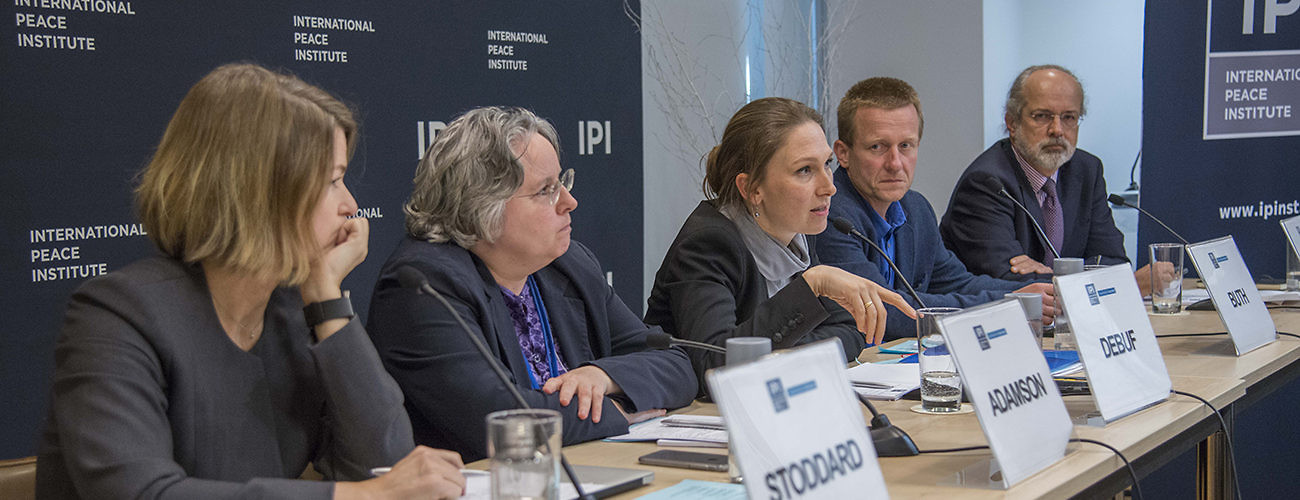“For humanitarian actors, staying away is not an option,” said Els Debuf, commenting on the increasing risks facing humanitarian workers. “That is what humanitarian action is all about. We must take measures to enable humanitarian action.”
Ms. Debuf, Head of Humanitarian Affairs at IPI, made the observation in introducing a March 1st meeting on “Strengthening Humanitarian Response in Insecure Settings.” The event, co-sponsored by IPI and Humanitarian Outcomes, was held to launch the Secure Access in Volatile Environments (SAVE) Study.
Abby Stoddard, a partner at Humanitarian Outcomes and lead researcher on the report, said it focused on four particularly dangerous environments for humanitarian workers – Afghanistan, Somalia, South Sudan, and Syria.
The report, she said, is essential because “insecurity has a negative effect on humanitarian action, and when it’s not measured, it’s easy to obscure the problem and not see the gaps, and partial humanitarian assistance.”
She broke the report down to three major findings.
The first was that “conflict and insecurity disrupts humanitarian processes and skews the humanitarian involvement to areas of lesser need.” This means that fewer aid workers end up in the most dangerous countries, she said.
The second was that “insecurity dictates how and where organizations operate, at least in the field, if not in headquarters,” she said. This creates the problem of an aid presence which is clustered in areas perceived to be safer for staff, despite these areas having less people in need. “Aid presence declined as needs in the area increased,” she explained.
Third, where humanitarians are deployed can be compromised by donor interests. She noted that increased financial risk, the possibility of financial loss, or corruption discourage organizations from entering insecure areas.
Dr. Stoddard emphasized, “Agencies need to openly address with their donors the political constraints and pressures. When you obscure the problem, you make the aid coverage seem better than it is, and thus agencies undermine their efforts and let political actors off the hook for not finding solutions.”
“Both sides need to get together and address this issue.” she said.
Simon Butt, Senior Security Advisor, UN Office for the Coordination of Humanitarian Affairs (UN-OCHA), spoke of the balancing act organizations must take to weigh risk against performance.
He outlined two principles to guide that decision-making. The UN “cannot expose staff to unreasonable risk,” he said, but “can accept risk if its benefits outweigh the cost.”
Joanna Adamson, Deputy Head of the Delegation of the European Union to the UN, shared Mr. Butt’s concerns. “It’s a balancing act,” she said. “Seen from Bamako or Niamey, I would often be going back to London, to my headquarters, saying: ‘Look, I am the ambassador to X country, I have to be there, otherwise, why am I there?’”
“So there is often a tension, and the level of ease with risk is very different sometimes, depending on where you sit, and of course when things go wrong, you start to go through the post facto justifications for ‘Why this? Why then?’ and the tolerance for risk suddenly becomes extremely low,” she said.
Pete Buth, Former Deputy Director of Operations for Médecins Sans Frontières (MSF) Holland, recalled humanitarian principles when considering whether to work with, or through, local militia. “You look at how that affects the way that we’re being perceived, how does it affect the assistance we provide, will we do more harm in the long-run?” he asked.
In today’s globalized world, working with one group locally can have unintended international consequences. “Unlike in the past, what you do in one part of southern Somalia is going to be known in central Afghanistan in no time. So perception has become global and consistency of humanitarian actors has become increasingly important,” he said.
Mr. Butt was emphatic about the need to maintain humanitarian separation from the military, given that the military often take sides in a conflict, and thereby inevitably put those they protect in danger.
“From a security risk management perspective, there is certainly at least one country I can think of where being accompanied by the military is more likely to bring an attack on you, than if you travel alone,” he said.
“Some like to rely on armed escorts. In many cases there is a false security to armed escorts unless you are extremely savvy to the ethnic breakdown of those escorts and where you are sending them, and where you are taking things,” he explained. “You’re asking for trouble. It is very risky.”
Els Debuf, Head of Humanitarian Affairs at IPI, moderated the conversation.








